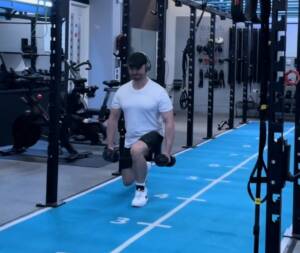
Squats are widely considered the king of a leg exercises, but the lunge is — or should be — a close second. Done correctly, lunges are a great movement to do.
Here are some of the benefits:
Improved Balance and Coordination
Lunges require a lifter to support themselves primarily on one leg (the other leg may or may not be used for assistance). The need for joint stability and control (in the ankle, knee, and hips) heightens this movement’s difficulty, increasing the neurological and muscular demands.
Seeing that many human movement patterns and fixed positions (such as the squat) rely heavily on both, increasing balance and coordination can lead to greater single leg performance (jogging , sprinting, jumping, formal sports, etc.).
Enhanced Muscle Growth
Unilateral training has been shown to increase muscle activation, which can lead to more forceful muscular contractions. One leg carries more of your bodyweight by performing lunges than it would during a bilateral squat. This is beneficial when trying to focus on the development of specific muscle groups.
Better Muscular Symmetry
Correcting muscular imbalances is important to the minimisation of injury in athletes and fitness buffs alike. Chances are, many of you have movement and muscular asymmetries that go unnoticed or unaddressed due to the great amounts of bilateral (two limbs at once) movements we do in our training.
Greater Glute Activation
Lunges address weaknesses in balance and coordination, as well as demanding dormant muscle groups to develop. The glutes are a powerful muscle group that can be targeted (especially in wide stance lunges), leading to enhancements in power output, decreased lower back pain, running economy, and speed.
